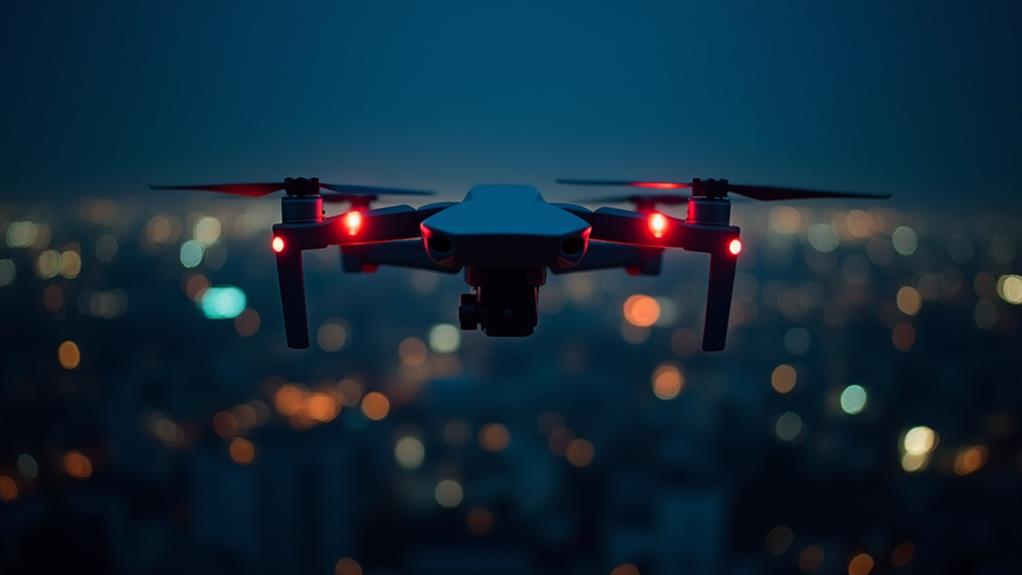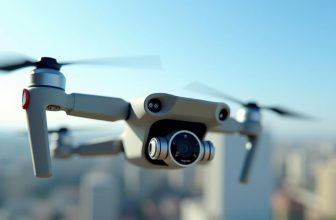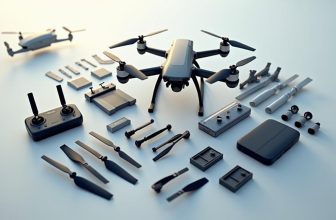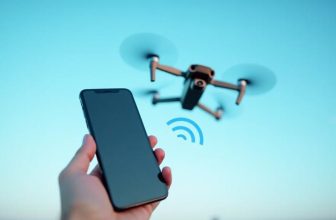
You might think that drones are just a blur in the night sky, but that's far from the truth. In reality, they transform into mesmerizing aerial displays, thanks to strategically positioned LED lights and reflective materials. But what makes them truly stand out is the thoughtful design behind their nighttime appearance. You'll find that drones are equipped with a range of visual features, from symmetrical light placement to high-visibility color schemes, all working together to create a unique visual signature. But how do these design elements come together to create the perfect nighttime drone?
Contents
- 1 Key Takeaways
- 2 Drone Lighting Systems
- 3 Types of Navigation Lights
- 4 Visibility in Low Light
- 5 Nighttime Drone Safety Features
- 6 LED Light Placement Strategies
- 7 Reflective Materials and Designs
- 8 Color Schemes for Visibility
- 9 Drone Body and Shape Design
- 10 High Visibility Propellers
- 11 Nighttime Drone Illumination Trends
- 12 Frequently Asked Questions
- 13 Conclusion
Key Takeaways
- Drones at night use strategically positioned LED lights to maximize visibility and comply with regulations such as those set by the FAA.
- Position lights on drones indicate orientation in space, typically consisting of red and green lights on the left and right sides.
- Anti-collision lights increase a drone's visibility from a distance, warning other air traffic of its presence with high-intensity lights.
- Symmetrical light placement creates a balanced and easily recognizable visual signature, enhancing the overall visual experience at night.
- Reflective materials and high-visibility colors can be used to maximize a drone's visibility, even when its lights are off or in low-light conditions.
Drone Lighting Systems
Most drone lighting systems consist of a combination of LED lights, which are strategically positioned around the drone's frame to maximize visibility.
These lights are usually mounted on the arms or body of the drone and are designed to provide a 360-degree visibility. As you examine a drone lighting system, you'll notice the lights are often color-coded and positioned to create a visually recognizable pattern, often referred to as the drone's "aesthetics."
When selecting a drone lighting system, you need to ponder lighting regulations, such as those set by the Federal Aviation Administration (FAA) in the United States.
These regulations dictate the intensity, color, and positioning of the lights to guarantee they don't interfere with other aircraft or disturb the public. You must also ponder the environmental factors, such as ambient light, that will impact the effectiveness of your drone's lighting system.
A well-designed drone lighting system not only enhances visibility but also contributes to a drone's overall safety and performance.
When outfitting your drone for nighttime operations, you'll need to ponder the types of navigation lights that will enable you to safely navigate through the dark skies.
As per aviation standards, navigation lights are a critical component for drone visibility and safety. These lights are designed to be compliant with light regulations, ensuring that your drone is visible from a distance.
To achieve this, you'll need to weigh the following types of navigation lights for your drone:
- Position Lights: These lights are used to indicate the drone's position and orientation in space. Typically, they consist of red and green lights on the left and right sides of the drone, respectively.
- Anti-Collision Lights: These lights are designed to increase the drone's visibility from a distance, warning other air traffic of its presence. They're usually high-intensity strobe lights that flash at a specific frequency.
- Navigation Strobe Lights: These lights are used to provide a visual indication of the drone's navigation status, such as its altitude and airspeed. They're typically used in conjunction with other navigation lights to provide an exhaustive visual representation of the drone's state.
Visibility in Low Light
When flying drones in low-light conditions, you'll notice a significant drop in visibility.
To counter this, many drone manufacturers turn to Light Emitting Diodes (LEDs) that provide high-intensity, focused illumination, helping you spot obstacles and navigate through dark environments.
Additionally, some drones are equipped with Night Vision Technology, such as infrared cameras, that amplify available light, allowing you to see more clearly in low-light settings.
Light Emitting Diodes
You're flying a drone at night, and one essential element to ponder is visibility.
Light Emitting Diodes (LEDs) play a substantial role in enhancing visibility in low light conditions. LEDs have a rich history dating back to 1962 when Nick Holonyak Jr. invented the first visible LED.
Since then, LEDs have become an integral part of various applications, including drone design.
LEDs offer several benefits for drones flying at night.
- Energy Efficiency: LEDs consume noticeably less power compared to traditional light sources, making them ideal for drones with limited battery life.
- Longer Lifespan: LEDs have a longer lifespan compared to traditional light sources, reducing the need for frequent replacements.
- Design Flexibility: LEDs can be easily integrated into a drone's design, allowing for a range of lighting configurations to suit specific needs.
Night Vision Technology
Night vision technology takes center stage in enhancing visibility in low light conditions.
As you explore drones at night, you'll notice that night vision technology isn't just about amplifying available light, but also about generating images in complete darkness. This technology uses image intensification, which takes tiny amounts of light and magnifies them, allowing you to see objects that wouldn't be visible to the naked eye.
You can also expect to see drones equipped with thermal imaging capabilities, which detect temperature differences in their surroundings.
This allows for nighttime surveillance in complete darkness, as objects and people emit heat that can be captured by the drone's thermal imaging camera. Thermal imaging produces a visual representation of heat signatures, making it easier to detect and track objects.
When it comes to nighttime surveillance, night vision technology is vital for drones.
It enables them to capture high-quality images and video, even in low-light conditions. With thermal imaging, drones can detect and track objects, making them ideal for search and rescue operations, security patrols, and wildlife monitoring.
Nighttime Drone Safety Features
Operating a drone in low-light conditions demands heightened attention to safety features that mitigate risks and enhance visibility.
As you navigate through the darkness, it's vital to rely on advanced technologies that safeguard your drone and its surroundings. Night mode sensors, for instance, play a pivotal role in detecting obstacles and adjusting to changing environments.
When flying at night, you should prioritize the following safety protocols:
- Object detection: Utilize advanced sensors that detect obstacles within a certain range, alerting you to potential collisions and allowing you to adjust your flight path accordingly.
- Geofencing: Establish virtual boundaries that restrict your drone's movement, preventing it from entering restricted areas or colliding with stationary objects.
- Return-to-home functionality: Program your drone to automatically return to its takeoff point in case of low battery or loss of signal, ensuring a safe and controlled landing.
LED Light Placement Strategies
When designing LED light placement strategies for your nighttime drone flights, consider symmetrical light placement to create a balanced and easily recognizable visual signature.
You can also experiment with patterned light displays that use sequences or shapes to convey information, such as flashing lights that indicate the drone's orientation or direction.
Symmetrical Light Placement
Hy Jam lorem, when designing a drone's LED light placement, symmetrical light placement is an essential consideration for creating visually appealing aerial patterns.
You want to create a balanced and harmonious light choreography that enhances the overall visual experience. Symmetrical placement can be achieved by mirroring the light arrangement on either side of the drone's center axis.
To create a symmetrical light placement, consider the following:
- Use identical LED strips or modules on both sides of the drone to create a mirrored effect.
- Place lights at equal distances from the center axis to maintain symmetry and balance.
- Experiment with different light patterns and animations to create a unique and visually striking aerial display.
When designing a symmetrical light placement, you should also consider the drone's size, shape, and flight pattern.
Patterned Light Displays
Creating patterned light displays involves strategically placing LED lights to generate intricate designs and animations in the night sky.
As you plan your display, consider the type of show you want to create – whether it's for a light festival or an aerial performance. You'll need to decide on a pattern or design, taking into account the number of drones and their positioning in 3D space.
When designing your pattern, think about the shapes and forms you want to create.
You can use geometric shapes, such as spheres, cubes, or cones, or opt for more organic shapes, like waves or flowers. Consider the color palette and how you can use different colors to add depth and interest to your design.
To create complex patterns, you can use a combination of LED lights with different intensities, colors, and flashing frequencies.
For example, you can create a gradient effect by gradually changing the color of the lights from one drone to the next.
Reflective Materials and Designs
Sixteen reflective materials are commonly used on drones flying at night, each with its own set of characteristics that interact with light in unique ways.
You'll notice that these materials can enhance visibility, even when the drone's lights are off. Reflective accents are strategically placed on drones to create a visual effect that's both functional and aesthetically pleasing.
Material innovations have led to the development of advanced reflective materials that can be integrated into drone designs.
These materials can be used to create complex patterns, shapes, and textures that interact with light in various ways.
Some common uses of reflective materials on drones include:
- Increasing visibility in low-light environments
- Creating a sense of movement or rotation through the use of dynamic reflective patterns
- Enhancing the overall visual appeal of the drone through the use of reflective accents and designs
Color Schemes for Visibility
When designing your drone for night operations, you'll want to focus on color schemes that maximize visibility, particularly those that incorporate high-visibility colors like fluorescent orange, yellow, or green.
These colors have a high reflectance value, which helps them stand out against a dark background.
High Visibility Colors
Across a dark sky, you'll want your drones to stand out with high-visibility colors that enhance their visibility.
High-visibility colors play a vital role in enhancing the visibility of drones at night. You can choose colors that are easily noticeable in a dark environment and apply them to the drone's body, propellers, or other components.
To make your drones more visible, consider the following high-visibility color options:
- Bright and bold colors like electric blue, orange, and yellow, which are highly visible against a dark sky.
- Neon accents like neon green, pink, and blue, which can be applied to specific components like the drone's arms or propellers to create a high-visibility effect.
- Color coding schemes that use a combination of colors to create a unique visual pattern, making it easier to identify and track the drone.
Reflective Lighting Schemes
To boost your drone's visibility at night, incorporate reflective lighting schemes that amplify its presence in the dark.
This involves strategically placing lights or reflective materials on your drone to create a visual signature that stands out against the night sky. Consider using aerial markings such as stripes, chevrons, or geometric patterns to create a unique visual identity for your drone.
When designing your reflective lighting scheme, think about the principles of light painting.
Light painting is a technique used to create glowing, ethereal effects by moving a light source over a period of time. By applying this principle to your drone's lighting scheme, you can create a mesmerizing display of light and color that grabs attention.
For maximum visibility, choose lights with high luminescence and a narrow beam angle to minimize light spill.
Consider using LED lights or electroluminescent tape to create a bright, consistent glow. By incorporating reflective lighting schemes into your drone's design, you can substantially enhance its visibility at night and reduce the risk of collisions or loss.
Drone Body and Shape Design
Streamlined aerodynamics is key to a drone's nighttime performance.
When designing a drone for nighttime flights, you'll want to focus on creating a body shape that reduces air resistance and optimizes maneuverability.
This is achieved by incorporating aerodynamic curves into the drone's design.
Curved lines and rounded edges help to reduce drag, allowing the drone to move more efficiently through the air.
You'll also want to weigh the merits of using modular frames, which can be easily customized to fit your drone's specific needs.
Modular frames provide a high degree of flexibility, making it easy to swap out components or upgrade your drone as needed.
Some key design considerations for a nighttime drone body and shape include:
- Aerodynamic curves: Incorporating curved lines and rounded edges to reduce drag and improve maneuverability
- Modular frames: Using modular frames to provide flexibility and make it easy to customize or upgrade your drone
- Compact design: Designing the drone body to be compact and lightweight, reducing air resistance and improving overall performance
High Visibility Propellers
Your drone's aerodynamic body shape is only one aspect of its overall nighttime performance.
When it comes to visibility, another vital component is the propellers. High visibility propellers play a significant role in enhancing your drone's nighttime appearance.
Propeller aesthetics can be customized to improve visibility, making it easier to track your drone's movements in low-light conditions.
Customizable propellers come in various shapes, sizes, and colors.
You can choose from a range of propeller designs that not only enhance visibility but also suit your drone's unique style. Some propellers feature reflective materials or bright colors that increase visibility from a distance. Others have unique shapes that create a distinct visual pattern when spinning.
Propeller customization also allows you to match your propellers with your drone's body color scheme, creating a cohesive look.
Additionally, some propellers feature LED lights or glow-in-the-dark strips that can be integrated into your drone's design, further enhancing visibility.
By customizing your propellers, you can improve your drone's overall nighttime appearance and make it easier to track its movements.
This attention to detail can elevate your drone's performance and aesthetic appeal.
Nighttime Drone Illumination Trends
As you look to enhance your drone's nighttime visibility, you're likely considering the latest trends in illumination.
Nighttime drone illumination trends focus on achieving peak visibility while adhering to illumination standards. Effective illumination enhances nighttime aesthetics and guarantees safety during low-light operations.
When designing your drone's illumination system, consider the following key trends:
- High-intensity LED lights: Strategically positioned to provide maximum visibility, these lights are energy-efficient and have a long lifespan, making them a popular choice for drone illumination.
- RGB color schemes: Customizable color schemes can be used to create unique nighttime aesthetics, differentiate your drone from others, and even convey operational status information.
- Adaptive lighting systems: These systems adjust light intensity and color based on ambient light conditions, guaranteeing peak visibility and minimizing power consumption.
Frequently Asked Questions
Can Drones Be Used During Heavy Rain at Night?
You can operate drones during heavy rain at night, but be cautious. Rainy conditions reduce visibility, and nighttime visibility is further compromised by water droplets on cameras, making navigation and obstacle avoidance extremely challenging.
How Loud Are Drones While Flying at Night?
"Actions speak louder than words," and when you're flying a drone at night, its nighttime noise can be a significant issue. You'll notice the aerial disturbance it creates, generating around 70-80 decibels of sound, audible from the ground.
Are There Specific Drone Laws for Nighttime Flying?
You'll find specific drone laws for nighttime flying governed by airspace regulations, requiring pilot certification under Part 107 rules. Visual line-of-sight is vital, and anti-collision lights are often mandatory, depending on the location and drone type.
Can I Use Drone Lights for Underwater Use?
You can't use standard drone lights for underwater use due to water resistance and corrosion risks. Specialized submersible lights are needed for underwater exploration, enhancing aquatic visibility in dark environments.
Do Drones Have Night Vision Capabilities?
You're in the dark, literally, when it comes to drone night vision. Fortunately, many drones have night surveillance capabilities, thanks to Infrared sensors that illuminate objects, allowing you to see in low-light conditions with crystal clarity.
Conclusion
As you gaze up at the night sky, a "darkness whisperer" comes alive – drones transforming into celestial ballets, their LED lights weaving an enchanting tapestry of color and motion. Strategically placed lights, high-visibility hues, and aerodynamic curves harmonize to create an aerial spectacle. With each precision-crafted design element, nighttime drones become mesmerizing works of art, marrying innovation and technology to redefine the evening skies. In this symphony of light, safety and aesthetics blend in perfect harmony.






